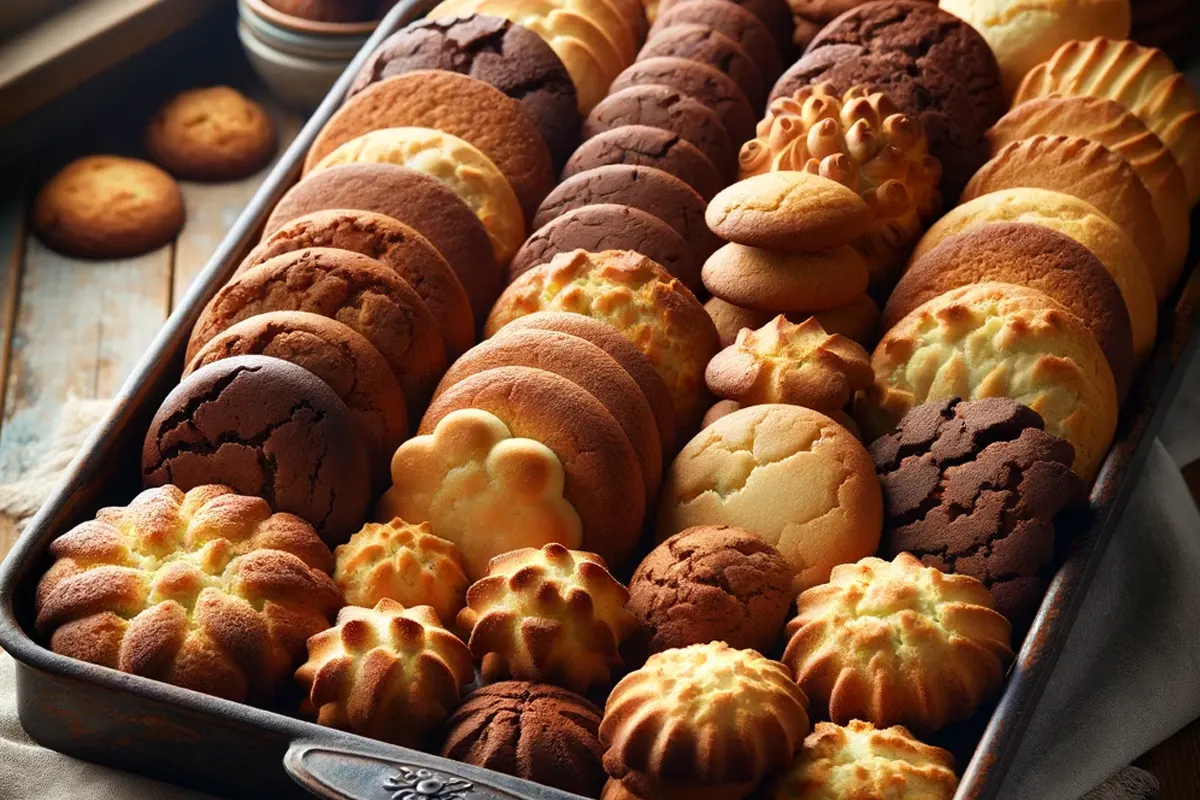Embarking on the journey to perfect the art of baking gluten-free cookies that boast a delightfully cakey texture can seem daunting at first. However, with the right knowledge and a sprinkle of baking magic, you can create treats that are not only safe for those with gluten sensitivities but are also irresistibly delicious. This article unfolds the secrets behind achieving that sought-after cakey consistency, from understanding the nuances of gluten-free baking to selecting the ideal ingredients and mastering essential techniques. Let’s dive into the world of gluten-free cookies, where every bite is a soft, fluffy delight.
Introduction to Gluten-Free Cookies
Understanding Gluten-Free Baking
Navigating through the realm of gluten-free baking is akin to exploring a new culinary language. It’s all about redefining textures and flavors while ensuring nutritional value. Gluten, a protein found in wheat, barley, and rye, offers elasticity and chewiness to traditional baked goods. Our mission? To recreate that magic without it.
Why, you might wonder, do some bakers end up asking, “Why are my gluten-free cookies cakey?” The answer often lies in the balance of ingredients and the science of gluten-free flours. Achieving that perfect cakey texture is a delicate dance between moisture, leavening agents, and the right flour blend.
Why Cakey Gluten-Free Cookies?
There’s something utterly comforting about a cakey cookie. It’s the perfect cross between a moist cake and a chewy cookie, offering a tender crumb that melts in your mouth. For those on a gluten-free diet, finding such joy in baked goods can be a rare treasure, much like discovering the delights of Gluten-Free Sugar Cookies. Cakey cookies provide a delightful alternative to their denser, sometimes gritty, counterparts.
In the quest for the perfect gluten-free cakey cookie, we’ll explore the essential components that make up these tender treats. From the science behind gluten-free flours to the art of balancing moisture, every element plays a pivotal role. So, preheat your ovens and get ready to embark on a baking adventure that promises to end with a batch of irresistible gluten-free cookies, cakey and light, just waiting to be devoured.
Key Ingredients for Cakey Texture
Achieving that soft, cakey texture in gluten-free cookies requires a bit of alchemy. Think of your kitchen as a lab where every ingredient plays a crucial role in the experiment. The MVPs here are:
- Gluten-Free Flour Blends: The cornerstone of any gluten-free baking, these blends often combine rice flour, potato starch, and xanthan gum., these blends often combine rice flour, potato starch, and xanthan gum to mimic the elasticity and structure that gluten provides in traditional baking. But here’s a twist – not all blends are created equal. Experimenting with different brands can lead to discovering the golden ratio for your perfect cookie.
- Baking Powder & Baking Soda: These leavening agents are the secret to the lift and airy texture we’re after. But remember, balance is key! Too much, and you might end up with cookies that taste more like mini cakes (though, is that really a bad thing?).
- Eggs: Or, for our vegan friends, a clever substitute like a flaxseed or chia seed ‘egg’. These bind the ingredients together, adding moisture and helping to create that tender crumb we’re all craving.
- Butter or Coconut Oil: Fat is essential for that rich, melt-in-your-mouth feel. Whether you’re keeping it classic with butter or opting for a plant-based alternative like coconut oil, this ingredient is what brings the indulgent texture to your gluten-free cookies.
- Sugar: Not just for sweetness! Sugar also helps in creating a tender texture by locking in moisture. Whether you’re using white, brown, or a more natural option like coconut sugar, it plays a pivotal role in the final texture of your cookies.

Gluten-Free Flour Blends
Navigating the world of gluten-free flour blends can be akin to finding your way through a maze. Each blend has its unique characteristics, with ingredients ranging from almond flour for richness to tapioca flour for that chewy texture. For a cakey cookie, a blend that includes a bit of starch, like cornstarch or arrowroot, can be your secret weapon. It lightens the dough, leading to that airy, tender crumb we’re aiming for.
But here’s a hot tip: don’t shy away from making your own blend! Mixing your flours allows you to tailor the blend to your taste and texture preferences, giving you control over the outcome of your baking adventures.
Healthy Substitutes
In the realm of gluten-free baking, the art of substitution is your best friend, similar to the creative culinary twists found in Gluten-Free Chicken Noodle Soup Recipe Tips. Swapping out traditional ingredients for healthier alternatives can not only cater to dietary needs but also add an exciting twist to your cookies.
- Applesauce or Mashed Bananas: These can replace some of the fat in the recipe, adding natural sweetness and moisture without the added calories.
- Almond Milk or Oat Milk: A splash of your favorite plant-based milk can add the necessary liquid to your dough without the dairy.
- Almond or Coconut Flour: Looking to boost the protein content? These flours can partially replace your base flour blend, adding a subtle flavor and nutritional punch.
Navigating the world of gluten-free cookies cakey in texture is an adventure filled with trials, triumphs, and lots of taste testing. With the right blend of ingredients and substitutes, you’re well on your way to mastering the art of gluten-free baking. And for those moments of doubt, when you find yourself asking, “Why are my gluten-free cookies cakey?” remember, it’s all in the magic of mixing the right ingredients together. So, preheat your oven, and let’s get baking!
For those keen on diving deeper into the world of gluten-free baking, exploring resources like King Arthur Baking Company can provide a wealth of knowledge, from premium gluten-free flour options to expert baking tips, ensuring your cookies are nothing short of perfection.
Step-by-Step Recipe for Cakey Gluten-Free Cookies
Begin with assembling your ingredients, ensuring everything is measured accurately, much like the precision required for Gluten-Free Cupcakes. Gluten-free baking is forgiving in flavor but demands precision in proportions.
Ingredients:
- 2 cups of your preferred gluten-free flour blend
- 1 teaspoon baking powder (to lift and lighten)
- 1/2 teaspoon baking soda (for that subtle expansion)
- 1/2 cup unsalted butter, room temperature (or coconut oil for a dairy-free option)
- 3/4 cup sugar (consider coconut sugar for a healthier twist)
- 2 large eggs (or flax eggs for a vegan variation)
- 1 teaspoon pure vanilla extract (for that aromatic depth)
- A pinch of salt (to balance and enhance flavors)
Instructions:
- Preheat and Prep: Start by preheating your oven to 350°F (175°C) and lining your baking sheets with parchment paper. This ensures your cookies don’t stick and allows for easy clean-up.
- Whisk the Dry Ingredients: In a large bowl, whisk together the gluten-free flour blend, baking powder, baking soda, and salt. This not only combines the ingredients but aerates them, contributing to the cakey texture.
- Cream the Butter and Sugar: In a separate bowl, use an electric mixer to cream together the butter and sugar until light and fluffy. This step is crucial for incorporating air and creating a tender crumb in your cookies.
- Add Eggs and Vanilla: Beat in the eggs, one at a time, followed by the vanilla extract. Ensure each egg is fully incorporated before adding the next to maintain the emulsion.
- Combine Wet and Dry: Gradually add the dry ingredients to the wet, mixing until just combined. Over-mixing can lead to tough cookies, so gentle folding is key.
- Scoop and Bake: Use a cookie scoop to drop dough balls onto your prepared sheets, spacing them about 2 inches apart. Bake for 10-12 minutes, or until the edges are lightly golden and the centers are set but still soft.
- Cool: Let the cookies cool on the baking sheet for 5 minutes before transferring them to a wire rack to cool completely. This resting phase is essential for achieving the perfect texture.

Baking Techniques and Tips
- Chill the Dough: If time allows, chilling the dough for at least an hour (or even overnight) can enhance the flavors and improve the texture, leading to thicker, cakey cookies.
- Use Room Temperature Ingredients: Ensuring ingredients like eggs and butter are at room temperature helps them to blend more seamlessly, contributing to a smoother dough and, consequently, a tender crumb.
- Invest in a Cookie Scoop: Uniformity is key in baking. A cookie scoop ensures consistent size and shape, leading to even baking and presentation.
- Monitor Oven Temperatures: Gluten-free cookies can be sensitive to temperature fluctuations. Consider using an oven thermometer to ensure accuracy and prevent over-baking, which could compromise the cakey texture.
Mastering the craft of baking gluten-free cookies with a cakey, soft texture is an enjoyable journey filled with sweet rewards. By following this detailed recipe and embracing the nuanced techniques of gluten-free baking, you’re well-equipped to create cookies that are not just delicious, but also cater to dietary needs and preferences. Happy baking!
Troubleshooting Common Baking Issues
It’s not uncommon to encounter a few bumps along the baking road, here are some typical challenges and how to tackle them. Here are some typical challenges and how to tackle them:
- Cookies spreading too thin: This can happen when there’s too much butter or fat in the dough, or if the dough wasn’t chilled long enough before baking. To prevent this, ensure you measure your ingredients accurately and consider chilling the dough for at least 30 minutes before baking. This not only helps the cookies maintain their shape but also enhances the flavors.
- Dry and crumbly cookies: Gluten-free flour blends can often lead to a drier dough due to their varied absorption rates. To combat this, you might want to increase the moisture content. Adding an extra egg or a splash of milk (dairy or non-dairy) can make all the difference, lending your cookies that moist, tender texture you’re after.
- Cookies not rising: If your cookies are coming out flatter than expected, it might be time to check your leavening agents. Ensure your baking powder and soda are fresh; they lose their effectiveness over time. Additionally, the delicate balance of acidic and alkaline ingredients in your dough can affect how well your cookies rise, so consider the chemistry of your ingredients when tweaking your recipe.
Moisture Control in Gluten-Free Baking
Moisture can be a tricky element to master in gluten-free baking. Here’s how to keep it in check:
- Choose the right flour blend: Some gluten-free flours, like coconut flour, are highly absorbent and can suck the moisture right out of your dough. Others, like oat flour, can add a lovely moistness. Experiment with your blends and don’t be afraid to adjust the liquid components of your recipe accordingly.
- Incorporate fruits or veggies: Ingredients like mashed bananas, applesauce, or grated zucchini can add moisture to your dough without making it overly wet. They also bring a nutritional boost and subtle flavors that can elevate your cookies.
- Mind your fats: The type of fat used in your recipe can greatly impact the moisture content of your cookies. Coconut oil, for example, can make for a moister crumb compared to butter. If you’re finding your cookies too dry, consider swapping out some or all of the butter for an oil-based fat.
Baking is as much an art as it is a science, especially when it comes to gluten-free cookies. Each ingredient and technique plays a crucial role in achieving that sought-after cakey texture. So, when you find yourself pondering, “Why are my gluten-free cookies cakey?” remember, it’s all in the delicate balance of moisture, leavening, and temperature control. With these tips and tricks up your sleeve, you’re well-equipped to turn any baking challenge into a delicious victory.
For additional insights and solutions to common gluten-free baking challenges, Food Allergy Research & Education offers a wealth of resources. Understanding food allergies and sensitivities can not only improve your baking but also ensure it’s safe and enjoyable for everyone.

Frequently Asked Questions
Why are my gluten-free cookies cakey?
Ah, the age-old question that stumps many a baker! The cakey texture in your cookies could be due to a variety of factors. It might be the result of too much moisture in your dough, an excess of leavening agents like baking powder or baking soda, or the type of gluten-free flour blend you’re using. Each of these elements contributes to the final texture of your cookie, so tweaking the ratios might just lead you to your ideal chewiness.
How can I ensure my gluten-free cookies aren’t dry?
The key to preventing dryness lies in the balance of ingredients and baking time. Adding a bit more fat, such as butter or coconut oil, can help lock in moisture. Another trick is to slightly underbake the cookies; removing them from the oven when they’re just set but still soft in the middle can make all the difference. Remember, they’ll continue to cook a bit more as they cool on the baking sheet!
Can I use any gluten-free flour blend for cookies?
While you might be tempted to grab any gluten-free flour off the shelf, not all blends are created equal when it comes to cookie baking. Look for a blend specifically formulated for baking, or consider making your own mix to include a balance of flours and starches. This ensures you get a good structure and texture in your cookies without them turning out too dense or gritty.
What’s the best way to store gluten-free cookies?
To keep those cookies tasting as fresh as possible, store them in an airtight container at room temperature. If you’ve baked a bit too many, you can also freeze them; just make sure they’re well-wrapped to avoid freezer burn. When you’re ready to indulge, a quick zap in the microwave can bring them back to their warm, soft glory.
Can I make these cookies vegan as well?
Absolutely! Making your gluten-free cookies vegan-friendly can be as simple as substituting a few key ingredients. Use a plant-based butter or oil for the fat, and swap out eggs for a flaxseed or chia seed ‘egg’. With these adjustments, you can enjoy delicious, cakey cookies that everyone can indulge in, regardless of dietary restrictions.
Diving into the world of gluten-free baking can be a thrilling adventure, full of discovery and, of course, delicious treats. With these FAQs in your back pocket, you’re well-equipped to tackle any challenge that comes your way, ensuring your gluten-free cookies are not just cakey, but utterly irresistible. Remember, baking is as much about the journey as it is about the destination, so don your apron, preheat that oven, and embrace the sweet world of gluten-free cookie baking!

